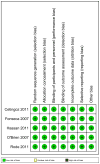Vaginal progesterone in women with an asymptomatic sonographic short cervix in the midtrimester decreases preterm delivery and neonatal morbidity: a systematic review and metaanalysis of individual patient data
- PMID: 22284156
- PMCID: PMC3437773
- DOI: 10.1016/j.ajog.2011.12.003
Vaginal progesterone in women with an asymptomatic sonographic short cervix in the midtrimester decreases preterm delivery and neonatal morbidity: a systematic review and metaanalysis of individual patient data
Abstract
Objective: To determine whether the use of vaginal progesterone in asymptomatic women with a sonographic short cervix (≤ 25 mm) in the midtrimester reduces the risk of preterm birth and improves neonatal morbidity and mortality.
Study design: Individual patient data metaanalysis of randomized controlled trials.
Results: Five trials of high quality were included with a total of 775 women and 827 infants. Treatment with vaginal progesterone was associated with a significant reduction in the rate of preterm birth <33 weeks (relative risk [RR], 0.58; 95% confidence interval [CI], 0.42-0.80), <35 weeks (RR, 0.69; 95% CI, 0.55-0.88), and <28 weeks (RR, 0.50; 95% CI, 0.30-0.81); respiratory distress syndrome (RR, 0.48; 95% CI, 0.30-0.76); composite neonatal morbidity and mortality (RR, 0.57; 95% CI, 0.40-0.81); birthweight <1500 g (RR, 0.55; 95% CI, 0.38-0.80); admission to neonatal intensive care unit (RR, 0.75; 95% CI, 0.59-0.94); and requirement for mechanical ventilation (RR, 0.66; 95% CI, 0.44-0.98). There were no significant differences between the vaginal progesterone and placebo groups in the rate of adverse maternal events or congenital anomalies.
Conclusion: Vaginal progesterone administration to asymptomatic women with a sonographic short cervix reduces the risk of preterm birth and neonatal morbidity and mortality.
Copyright © 2012. Published by Mosby, Inc.
Conflict of interest statement
DISCLOSURE: The majority of the authors report no conflict of interest except as stated in this paragraph. Dr. John M. O’Brien was involved in studies of progesterone gel treatment for preterm birth prevention sponsored by Columbia Laboratories, Inc., the manufacturer of the preparation used in the PREGNANT trial and a previous trial of vaginal progesterone in women at risk for preterm delivery. Dr. O’Brien serves on Advisory Boards and is a Consultant for Watson Pharmaceuticals, a company with a financial interest in marketing vaginal progesterone gel for the prevention of preterm birth. He and others are listed in the patent on the use of all progesterone compounds to prevent preterm birth. (US Patent Number 7,884,093: Progesterone for the Treatment and Prevention of Spontaneous Preterm Birth). George Creasy is an employee of Columbia Laboratories, Inc.
Figures
Comment in
-
Vaginal progesterone for asymptomatic cervical shortening and the case for universal screening of cervical length.Am J Obstet Gynecol. 2012 Feb;206(2):101-3. doi: 10.1016/j.ajog.2011.12.008. Epub 2011 Dec 16. Am J Obstet Gynecol. 2012. PMID: 22284154 No abstract available.
References
-
- Mathews TJ, Menacker F, MacDorman MF. Infant mortality statistics from the 2002 period: linked birth/infant death data set. Natl Vital Stat Rep. 2004;53:1–29. - PubMed
-
- Martin JA, Hamilton BE, Sutton PD, et al. Births: final data for 2007. Natl Vital Stat Rep. 2010;58:1–85. - PubMed
-
- Ananth CV, Vintzileos AM. Epidemiology of preterm birth and its clinical subtypes. J Matern Fetal Neonatal Med. 2006;19:773–82. - PubMed
Publication types
MeSH terms
Substances
Grants and funding
LinkOut - more resources
Full Text Sources
Other Literature Sources
Medical




